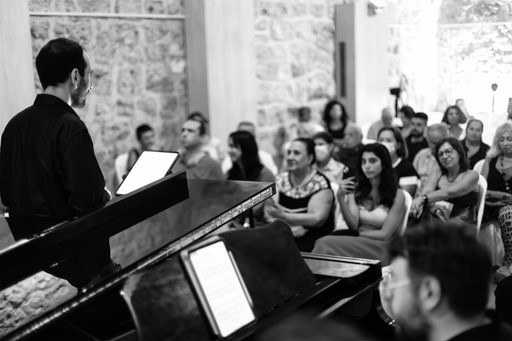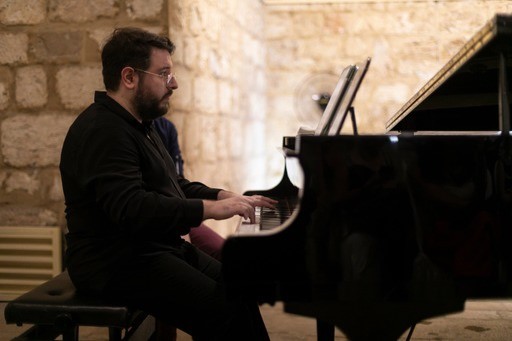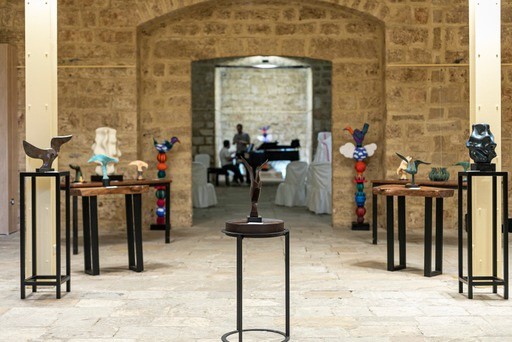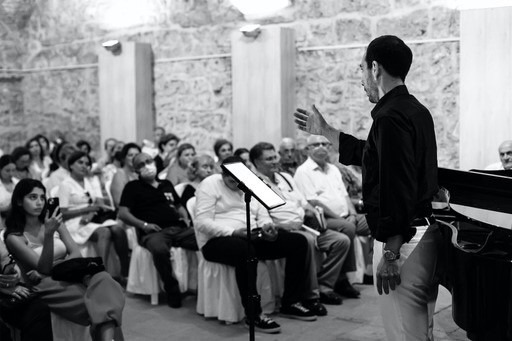As part of the concerts organized by the Bacchus Social Club, the Lebanese baritone Fady Jeanbart offered, on Tuesday August 16, an exhilarating reading of a kaleidoscopic bouquet of lyrical works, full of verve and light, served by a meticulous painter sounds, Elie Sawma, showing an exquisite interpretative maturity and a prodigious musical passion.
At the dawn of the golden age of music in Lebanon, marked mainly by the creation of the Baalbeck Festival in 1956, artistic rigor had the solemnity of a true religion. Today, more than half a century later, in the twilight of this era, punctuated by amateurism, the Lebanese music scene embodies the very meaning of decadence or even slump, as illustrated in Two old men eating soup of Francisco de Goya, or in more Nietzschean terms, the devaluation of values, particularly cultural and artistic. Despite this venomous slump that gnaws at the country of the Cedars, there are artists, the blacksmiths of a new golden age, who are trying ardently and against the tide to restore Art to its former glory. Baritone Fady Jeanbart and pianist Élie Sawma are part of this line of musicians who, endowed with a finely sculpted talent, feel a compelling, almost religious need to create great music. On Tuesday August 16, at 8 p.m., the crypt of the Saint-Joseph church in Monnot witnessed the harmonic and symbiotic intoxication of these two colorful artists who gave each other the line in the context of a concert, entitled “Note for Peace”, organized by the Club social Bacchus.
suggestive poetry
From the very first notes, Élie Sawma deploys a palette of dreamlike harmonic colors that seduce by the wide range of its nuances of an intensely suggestive poetry. It is, in fact, through an arrangement for piano of El cant dels ocells (Birdsong) by Spanish composer Pablo Casals, that the Lebanese pianist opens the concert, explicitly placing the evening under the sign of peace and freedom. The second piece of the concert, Dolente immagine di Girl mia (Painful image of Phyllis), lets discover the warm and fleshy stamp of Fady Jeanbart which flourishes admirably in the throes of Bellinian romanticism. The baritone manages to breathe infinite nuances into this song, devoid of all sorts of embellishments, and in an almost syllabic style, thereby accentuating the pathos of this funereal air which flows languidly back into the minor mode, with the exception of a few bars in the middle section in E flat major. If the singer never sacrifices emotion to technique by skillfully measuring his breath and elegantly mastering the art of legato (both essential for an authentic performance of this piece), it betrays, however, fleetingly but without a shadow of a doubt, the spirit of the score in its final section by amplifying one of the most dramatic passages, ” Riposa in pace ” (“Rest in Peace”), marked pianissimo.
Symphonic colors
This detail, however, remains minor compared to the luminous performance of the Lebanese baritone to whom this musical “sin” is immediately forgiven. With the complicity of Sawma who strives to show the expressive resources of his instrument (sometimes not very obedient), he highlights an attractive symphonic color, emphasizing a tone always as nuanced in Terra e mare (Land and Sea) by Giacomo Puccini. The two artists then tell their music like true impressionist painters, embarking on a journey of shadow and light at the very heart of Italian verismo and oscillating between rhythmic motifs, melodic and vocal lines which illustrate, with commendable accuracy , the “poplars”, the “strongest windstorms”, but above all the “voice of the sea”. Endowed with an obvious vocal intelligence, Jeanbart navigates easily between the characters and depicts, in his third play, Aprile by Francesco Paolo Tosti, the themes of spring and love. His clear tone, combined with a range of lyric baritone (which we know him), allows him to survey, without difficulty, the most thorny passages as well as the passggio secondo peaking at E 4. Armed with a rubato dignified and natural, striking the right balance betweenaccelerando and the ritardandohe also brilliantly notes the rhythmic pitfalls imposed by the piano accompaniment in arpeggio, and certain syllabic constraints which could have contradicted the indication of molto legato of the composer.

hypnotic chiaroscuro
The evening continues with An invitation to travel by Henri Duparc, a French musical work based on the eponymous poem by Charles Baudelaire, imbued with the ferment of German Wagnerian lied. Sawma’s accompaniment is that of a seasoned chamber musician who is never in confrontation with the soloist, but who actively engages with him in a dreamlike hypnotic spree, accentuated by a well-balanced succession of crescendo and decrescendo. Its fluid and limpid sixteenth notes give this piece a calm eloquence, where everything “is only order and beauty, luxury, calm and voluptuousness”. The continuous alternation of minor and major modes allows the two artists to paint, not without fault, a chiaroscuro remembranesque. However, the baritone’s voice slips away in certain high notes, making it harsh and shaky. To end the first part of the concert in style, Élie Sawma offers an interpretation of a miniature, yet pivotal work, in Impressionist colours, by Maurice Ravel, the first movement of his Sonatina, which asserts the post-Lisztian style of composition, based on organic harmonic development and the manipulation of the simplest and most fundamental musical material. If Sawma’s performance is accomplished, he sometimes lacks precision in some of his inspirations, making certain passages boring, but the eloquence of his assertive sounds based on the art of cantable allows him to always come out a winner.

saucy sounds
The second part of the concert will be particularly marked by In der Fremde (Abroad) by Robert Schumann and Atchan ya Sabaya (I’m thirsty, women) by Toufic Succar. Jeanbart’s reading of the German masterpiece (excerpt from Liederkreis, op.39) reaches heights of romantic purity that awaken old memories of a looming storm, death and loneliness. The combination of the exceptional sense of intonation of the baritone and the cheeky sonorities of the piano provokes a pleasant alchemy, put at the service of an expressiveness made of daydreaming. This same lyricism will lend voice, in the last part of the recital, to the internal antagonisms of heart and soul in the Serenade by Franz Schubert: we thus discover a new Fady Jeanbart (who stood out in his previous concerts for his interpretation of arias of comic character) projecting his warm and velvety voice with dramatic weight. As for the work of Succar, we note the usual qualities of Arabic diction of the baritone and his care given to the vocal line relating to the exoticism of European musical orientalism. The Lebanese pianist will, in turn, pay tribute to Toufic Succar by bringing his Minuet in G major, an interpretation that calls for silky but not syrupy sensibility and architectural playing. The public is then carried away by this musical flow, somewhat monotonous should it be noted all the same, animated by a soloist in full introspection.
Finally, we will retain, from the last part of this sparkling concert, the dynamic interpretation of Hai già vinta la causa (You have already won the case), excerpt from Marriage of Figaro by Wolfgang Amadeus Mozart. Clearly more at ease in Opéra bouffe, Fady Jeanbart enchants with his beautiful stage presence and his homogeneous and well-kept phrasing. The piano accompaniment will instil a notable dynamic in this masterpiece but will unfortunately be very marked by a romantic signature. Acclaimed by the public, the duo performs a remarkable encore, the brilliant apotheosis of a high-level concert: the famous aria from Figaro, taken from the Largo al factotum from the Barber of Seville composed by Gioachino Rossini. We are thus witnessing a surge of technical prowess by the Lebanese baritone who takes advantage of the opportunity to play the peacock with a certain charisma. Thus, the Lebanese duo manages to take up this demanding but exhilarating challenge of merging harmonic richness and lyrical refinement.


